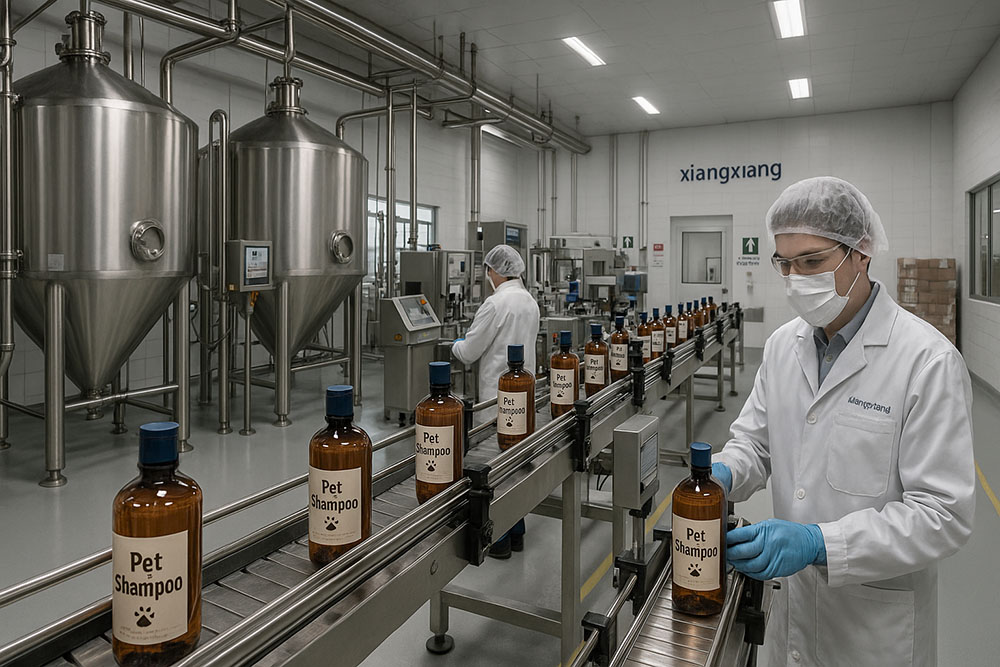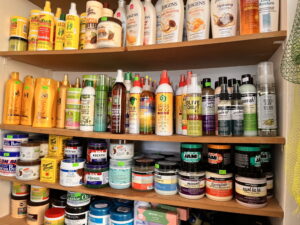Best Guide to Creating Your Own Private Label Pet Shampoo

Who this guide is for
You already run a consumer brand or operate offline chains, wholesale distribution, and online channels. You want to extend your portfolio with your own Private Label Pet Shampoo line—built to your brand standards, at healthy margins, and compliant in your target markets. This guide walks you, step by step, from idea to launch to scale. It’s written by xiangxiang, a dedicated pet shampoo manufacturer/OEM partner that helps brands like yours move fast without sacrificing quality.
TL;DR: You’ll get frameworks, formulas, packaging advice, timelines, unit-economics models, label templates, regulatory snapshots, QA checklists, and a ready-to-use RFQ brief to send to manufacturing partners.
1) Market Opportunity & Positioning
Why Private Label Pet Shampoo now?
Category growth: Pet ownership and humanization continue to lift grooming spend. Consumers want salon-like results at home, and trust retailers’ own brands when quality is proven.
Margin control: Private label allows you to own the value chain and protect contribution margin while competing against national brands.
Channel synergy: If you already sell treats, accessories, or cleaning products, shampoo is a logical, basket‑building add-on.
Segment the opportunity
Consider segmenting by:
Species: Dog, Cat (cats often require milder, fragrance‑reduced options).
Life stage: Puppy/kitten (tear‑mild), adult, senior.
Coat type: Short, long, curly/double coat, white/brightening, sensitive skin.
Functional need: Deodorizing, moisturizing, anti‑itch/soothing, deshedding, whitening/brightening, flea & tick (note: different regulatory status), waterless/foam, 2‑in‑1 shampoo+conditioner.
Lifestyle: Outdoor/adventure, show‑quality grooming, fragrance‑free/natural, eco‑conscious (biodegradable, refillable).
Competitive audit
Identify the top 10 SKUs in your market by sales velocity and reviews.
Map price vs. proposition (natural, medicated, grooming‑grade, eco, hypoallergenic).
Note packaging formats, sizes, and signature scents.
Read negative reviews: list the top 5 frustrations (e.g., lingering odor, harshness, thin viscosity, residue, leaky caps).
Pick two differentiation axes (e.g., “sensitive‑skin authority” + “clean, modern design”).
Positioning choices
Premium care (salon‑inspired results, plush feel, signature fragrance)
Derm‑gentle (sensitive skin, hypoallergenic vibe, fragrance‑light)
Outdoor/deodorizing (enzyme boosters, odor control)
Eco‑minimal (short INCI list, recycled bottles, concentrates/refills)
Groomer‑grade (dilutable concentrates, gallons for B2B + 16 oz retail)
Tip: Own a hero benefit and a signature sensorial (foam quality + rinse feel + post‑wash coat handfeel). That’s what customers remember.
2) Product Strategy & SKU Architecture
Start with a focused core
A disciplined first wave prevents inventory sprawl:
Hero Shampoo (All‑Coat, Moisturizing or Sensitive)
Deodorizing Shampoo (odor neutralizing)
2‑in‑1 Shampoo + Conditioner (time‑saving households)
Leave‑in Conditioner / Detangler Spray (post‑bath combability)
Optional: Waterless Foam for quick cleans between baths
This 3–5 SKU core covers ~70–80% of demand. Add specialist variants later (whitening, puppy, cat‑specific) based on feedback.
Size strategy
Retail: 300–500 mL (10–17 oz) bottles; trial 60–100 mL minis.
Pros/Backbar: 1 L / 1 gal concentrates (dilution 1:10 to 1:32 depending on formula).
Refill: 1 L pouches or 2–5 L jugs for eco and subscription programs.
Scent strategy
Signature scent: One ownable fragrance family (fresh clean, green citrus, soft powder, warm vanilla) with low IFRA allergen load.
Fragrance‑free variant for sensitive customers and cats.
Claims guardrails
Safe zone: “Cleans gently,” “Moisturizes,” “Helps detangle,” “Neutralizes odor,” “Enhanced shine,” “Supports healthy coat.”
Caution: Drug/biocidal claims (e.g., “kills fleas/ticks,” “treats dermatitis”) may move the product into a regulated category in many markets. Keep grooming claims unless you plan for appropriate registrations.
3) Formulation Fundamentals (What’s Inside Your Shampoo)
A great Private Label Pet Shampoo balances mild cleansing, skin compatibility, coat aesthetics, fragrance, and stability.
3.1 Surfactant system (the cleansing engine)
Primary surfactants (mild): Cocamidopropyl Betaine, Sodium Cocoamphoacetate, Sodium Lauroyl Sarcosinate, Sodium Lauroyl Methyl Isethionate, Decyl/Capryl Glucoside. These deliver gentler cleansing than harsher sulfates.
Boosters/secondary: Disodium Laureth Sulfosuccinate, Coco-Glucoside, Lauryl Glucoside to tweak foam and mildness.
Why mildness matters: Pet skin is generally more neutral in pH than human skin; overly harsh or acidic formulas can disrupt the barrier, leading to dryness and itch.
3.2 Conditioning & slip
Polyquaterniums (e.g., PQ‑7, PQ‑10) for combability.
Silicone options: Dimethicone or amodimethicone for shine and frizz control (use lightly for easy rinse). Silicone‑free alternatives include quaternized plant polymers and esters.
Fatty alcohols/esters: Cetearyl Alcohol, Isopropyl Myristate, Cetyl Esters to enhance feel (more common in 2‑in‑1 systems).
3.3 Sensory & viscosity
Thickeners: Electrolyte builds (NaCl with certain systems), Acrylates/C10‑30 Alkyl Acrylate Crosspolymer, or Xanthan Gum (for natural leaning). Viscosity targets affect pour and perceived quality.
Pearlizers/Opacifiers: Glycol Distearate gives that creamy, pearly look; keep usage low for fast rinse.
3.4 Odor control
Enzymes (protease) or zinc ricinoleate can bind malodor. Ensure enzyme stability and label appropriately.
3.5 Preservatives (keep it safe)
Favor modern, formaldehyde‑free systems: Phenoxyethanol + Ethylhexylglycerin, Sodium Benzoate + Potassium Sorbate (with proper pH), Caprylyl Glycol blends. Pass a Preservative Efficacy Test (PET/Challenge Test).
3.6 pH and buffers
Target a near‑neutral pH typically in the 6.0–7.5 range to respect pet skin. Use compatible buffers (citric acid/NaOH) and re‑verify after fragrance and color are added.
3.7 Fragrance & allergens
Choose IFRA‑compliant fragrances. Offer fragrance‑free for sensitive users and cats. Avoid heavy allergen loads and strong musk in cat lines.
3.8 Color & naturals
Use CI‑approved colorants at low levels or stay dye‑free. For “natural” lines, prioritize plant‑derived surfactants and readily biodegradable components.
3.9 What about flea & tick?
True pesticidal/biocidal action generally requires registration (e.g., EPA in the U.S., BPR in EU). If you don’t plan to register, keep claims to grooming only (e.g., “helps wash away dirt and debris”).
4) Safety, Testing & Claims Substantiation
Core test plan (recommended)
Stability: 40°C/75% RH accelerated, 4°C, and ambient; 3–6 months or protocol‑equivalent. Watch color, viscosity, pH, scent, phase.
Preservative Efficacy Test (PET): Challenge with standard organisms; demonstrate log reductions per accepted benchmarks.
Microbiological limits: TAMC/yeast/mold within safe limits; absence of pathogens.
Compatibility: Formula vs. bottle/closure/label/liner; check swelling, paneling, leakage.
Irritation screening: In‑vitro or human repeat insult patch test (HRIPT) for human exposure handling; opt for non‑animal alternatives.
Transport: Freeze/thaw cycles; drop tests for packaging.
Claims files
Maintain a claims dossier with:
Formulation rationale and literature support.
Test reports (stability, PET, micro).
Consumer or grooming‑panel data (e.g., 80% agree coat feels softer).
IFRA certificates, allergen statements, and SDS.
Label warnings (typical, adjust to market)
“For external use on pets only.”
“Avoid contact with eyes. If contact occurs, rinse with water.”
“Keep out of reach of children.”
Storage conditions and batch/lot code.
5) Packaging, Labeling & Design
5.1 Primary packaging
Bottles: PET (clarity, recyclable), HDPE (chemical resistance), PCR content for sustainability claims.
Closures: Disc‑top, flip‑top, pumps; foamer pumps for waterless cleansers.
Pouches: Refill pouches reduce plastic and shipping weight.
Gallon/Pro jugs: With induction seal and child‑resistant caps if needed.
5.2 Functional details
Viscosity‑closure match: Ensure orifice size fits product thickness.
No‑leak seals: Induction seal + pressure‑sensitive liner.
Label stock: Waterproof, bath‑safe; consider direct‑print for gallons.
5.3 Artwork & compliance elements
Your front/back labels should reserve space for:
Brand & product name with species/lifestage.
Net contents (metric + US customary where relevant).
Key benefits: 2–4 bullets (grooming claims only).
Directions: Dilution (if any), contact time, rinse instructions.
Ingredient list (INCI where applicable) in descending order.
Warnings, lot/batch, MFG/Distributed by with address.
Barcodes: EAN/UPC; QR linking to product page and batch verification.
Recycling marks and “Not tested on animals” (if substantiated).
5.4 Dieline checklist
Bleed and safe areas confirmed
Regulatory minimum font sizes
All claims cleared
IFRA/allergen disclosure (if required by market)
Variable data zones (lot/expiry) defined
Contrast verified for legibility in wet environments
6) Compliance Snapshots (Not legal advice—confirm locally)
United States
Most pet shampoos are treated as consumer grooming products; avoid drug claims (treat, heal, medicate) unless you pursue appropriate pathways.
Flea & tick: Typically EPA‑registered pesticides when claiming kill/prevent; registration, specific actives, and labeling required.
Follow general product safety, truthful advertising, and state labeling norms; maintain SDS and traceability.
European Union / United Kingdom
Pet shampoos sold as grooming products fall under General Product Safety and chemical/biocide rules where relevant.
Biocidal claims (e.g., insecticidal) trigger BPR requirements; avoid unless planned.
Ensure REACH/CLP classifications where applicable (mixture classification, labeling if hazards present). Provide appropriate safety information to downstream users.
Canada
Grooming shampoos: consumer products; avoid drug/pesticide claims. For antiparasitic claims, consult PMRA.
Australia / New Zealand
Grooming products are generally consumer goods; veterinary/biocidal claims can invoke APVMA (AU) or ACVM (NZ) controls.
Southeast Asia snapshot
Requirements vary by country; maintain SDS, label in local language, importer/distributor details, and avoid therapeutic claims.
Best practice: Build a regulatory matrix for your target countries with claim limits, label languages, importer details, and any registration needs.
7) Working With a Private Label Manufacturer (Process, MOQs, Timelines)
Engagement models
Stock base + light customization: Choose from proven bases; customize fragrance, color, viscosity, packaging, artwork. Fastest path.
Custom development (NPD): Bespoke formula to your brief; longer timeline; unique IP positioning.
Typical process
Discovery & Brief (Week 0–1)
Target species/lifestage, benefits, scent strategy, “free‑from” lists.
Packaging format, sizes, channel plan, price targets.
Compliance markets and claims guardrails.
Formula Proposal & Bench Samples (Week 1–3)
1–3 base directions with rationale; send lab samples.
Feedback & Iteration (Week 3–6)
Adjust foam, rinse feel, scent intensity, viscosity, color.
Pilot, Stability & PET (Week 6–14)
Begin accelerated stability, PET challenge; artwork development.
Pre‑Production (PP) & Packaging Inbound (Week 10–16)
Approve golden samples, print labels, order bottles/pumps.
Production & QC (Week 16–20)
Batch manufacture, fill, pack; QC release with COA & micro.
Logistics & Launch (Week 20+)
Book freight, final inspections, inbound to DCs, pre‑sell.
Note: Timelines vary with customization depth and test windows. Stock formulas can compress significantly.
MOQs & lead times
Stock‑base PL: MOQs from 1,000–3,000 units per SKU typical for retail sizes; gallons by pallet.
Custom NPD: Higher MOQs (3,000–10,000+) due to minimums on raws and packaging.
Lead times: 6–12 weeks after approvals for production windows; add time for testing and packaging procurement.
Quality frameworks
Prefer factories operating to GMP (e.g., ISO 22716) with documented batch records, change control, and traceability.
8) Supply Chain, Incoterms & Logistics
Incoterms (choose your risk/ownership point)
EXW/FOB: You arrange freight; best if you have consolidations.
CIF/CFR: Supplier books to your port.
DAP/DDP: Landed to your DC/warehouse; fewer moving parts.
Freight & packaging for transit
Use UN‑tested outer cartons for durability, even if non‑hazmat.
Polybag or shrink each bottle; seal caps + induction liners.
Palletize to avoid top‑loading damage; add “This side up” where needed.
Documentation packet
Commercial invoice, packing list, HS codes.
COA, micro test summary, SDS, declaration of conformity.
Country‑specific documents (if required) and label proofs.
9) Unit Economics & Pricing Strategy
Build your COGS (landed)
Bulk formula cost (per kg/L)
Packaging (bottle, cap/pump, label, shipper)
Fill & pack labor
Overhead & QA
Freight & duty (to DC)
Margin stack (illustrative)
MSRP (retail): aim that your contribution margin after retailer/marketplace fees and marketing remains healthy.
Wholesale: Retailer margin commonly 40–60% depending on channel and promo funding.
Example calculator (per 500 mL bottle)
Bulk formula: $0.85
Bottle + pump + label: $0.60
Fill/pack/overhead/QC: $0.40
Carton & pallet share: $0.10
Inbound freight & duty: $0.25
COGS landed: $2.20
Wholesale price: $5.00 ⇒ Gross margin 56%
MSRP: $9.99–$12.99 (depending on channel). After promo/fees, model contribution.
Tip: Protect price architecture across channels; use size/pack differentiation to avoid direct price conflict.
10) Go‑To‑Market Playbook
10.1 Retail & wholesale
Sell‑in kit: 1‑pager, brand story, hero claims, test data, price list, planograms.
Retail training: quick product knowledge sheets; emphasize coat feel and fragrance trial.
Promotions: BxGx, bundles (shampoo + leave‑in), seasonal scents.
10.2 E‑commerce (your site)
PDP basics: benefit‑led copy, full INCI, dilution/use, FAQ, safety notes.
Video: 30‑sec demo of lather, rinse, coat afterfeel.
UGC & reviews: sample early to VIPs; automate review asks.
Subscriptions: refills or multi‑pet bundles.
10.3 Marketplaces (Amazon, Shopee/Lazada, etc.)
Clear claims (no regulated promises), bullet benefits, A+ content.
Variations: scent/size; keep images consistent.
Fulfillment choice: balance FBA/3P by country.
10.4 Groomers & vets (non‑drug lines)
Offer concentrates and backbar jugs; provide dilution charts.
Sampling program; tiered wholesale pricing.
10.5 Content & brand
Pillars: Gentle clean, Happy coat, Responsible care.
Blog/SEO: “How to choose a Private Label Pet Shampoo,” “Why pH matters for pet skin,” “Waterless grooming between baths.”
Social: bath transformations, before/after, scent storytelling.
11) Quality Assurance, Traceability & Continuous Improvement
Batch documentation: raw lot numbers, mixing parameters, in‑process checks (pH, viscosity), fill weights, torque, appearance.
Release criteria: COA (pH, viscosity), micro counts, appearance, packaging QC.
CAPA: define corrective/preventive actions for complaints.
Post‑market surveillance: monitor returns, track reasons (leak, scent too strong, skin reaction), iterate.
12) Templates & Tools
12.1 Product Brief Template (send to manufacturer)
Brand/Company:
Markets: (countries/regions)
Channels: (retail, wholesale, online, marketplace)
Target launch date:
SKU(s): (e.g., Moisturizing Dog Shampoo 500 mL; 2‑in‑1 300 mL)
Benefits/Claims (grooming only):
Fragrance strategy: (signature scent / fragrance‑free)
Color/appearance: (clear/pearl/milky)
pH preference: (near neutral)
Free‑from list: (e.g., SLS, parabens, formaldehyde donors)
Packaging: (bottle type, cap/pump, label, secondary, master carton)
Artwork language(s):
Compliance notes: (no pesticidal claims, etc.)
Testing expectations: (stability, PET, micro)
MOQ and price targets:
Incoterm: (FOB/DAP/DDP)
Documentation: (COA, micro, SDS, IFRA, allergen)
Competitive benchmarks: (brand, SKU, price)
Other notes:
12.2 RFQ Email Template
Subject: RFQ – Private Label Pet Shampoo (Retail + Pro SKUs)
Hello [Supplier],
We are launching a Private Label Pet Shampoo line across retail, wholesale, and online channels and seek an OEM partner.
Scope: [# of SKUs, sizes] Customization: [stock base/custom], fragrance [type], color [if any] Testing: Stability + PET + micro; standard documentation package Packaging: [bottle/cap/label specs] MOQs: [per SKU] | Incoterm: [FOB/DAP/DDP] Target markets: [countries] Launch window: [date]
Please share:
Ex‑works/FOB pricing by volume breaks
MOQs and lead times (dev + production)
Available stock bases and sample timeline
QA certifications (e.g., GMP/ISO 22716)
Standard docs (COA, SDS, IFRA)
Thank you,
[Name, Title]
[Company]
[Contact]
12.3 Label Copy Template (back panel)
Directions: Wet coat thoroughly with warm water. Apply shampoo and massage into a rich lather, avoiding eyes and ears. Rinse well. Repeat as needed. For best results, follow with [Brand] Leave‑In Conditioner.
For external use on pets only. Avoid contact with eyes. Keep out of reach of children.
Ingredients: Water (Aqua), [Surfactants], [Conditioners], [Humectants], [Fragrance (Parfum)], [Preservatives], [Colorants].
Net Contents: 500 mL (16.9 fl oz)
Distributed by: [Company, Address]
Lot/Batch: [Variable]
Made in: [Country]
Elevate Your Brand, Grow Your Sales
R&D support, stability testing, and compliance files aligned to your launch calendar—shortening time-to-market and accelerating revenue.
13) How to Work With xiangxiang
Who we are: A specialized manufacturer of Private Label Pet Shampoo and related grooming products, supporting both stock‑base customization and full custom development.
What you can expect:
Multiple mild, proven base formulas (moisturizing, deodorizing, 2‑in‑1, waterless, cat‑friendly) that pass PET and stability.
Scent library curated for pets (signature, low‑allergen options) and fragrance‑free alternatives.
Packaging sourcing or fill‑only options if you supply components.
Documentation: COA, micro summary, SDS, IFRA, allergen statements.
QA & Traceability: Batch records, change control, continuous improvement.
What we need from you (to start fast):
Completed Product Brief (Section 12.1)
Target markets & claims guardrails
Packaging preferences and artwork languages
Forecast/MOQ comfort range and launch window
Typical next steps: Discovery call → Samples in ~1–2 weeks (stock base) → Feedback loop → PP approval → Production booking.
To begin, contact us with “PL Pet Shampoo Brief” in the subject and we’ll assemble your sample kit.
14) FAQ
Q: Can I make the same base work for dogs and cats?
A: Often yes for grooming claims, but consider a fragrance‑reduced or fragrance‑free cat variant and keep pH and mildness tight. Avoid strong essential oils around cats.
Q: Do I need tear‑free?
A: “Tear‑free” is more about reduced eye irritation than literally no tears. Keep surfactants mild and avoid eye exposure in directions.
Q: How do I talk about sensitive skin without drug claims?
A: Use comfort language (gentle, soothing, moisturizes, supports coat health) and avoid therapeutic terms (treats, heals, cures).
Q: What about whitening shampoos?
A: Optical brighteners and blue/violet tints can neutralize yellowing on white coats. Keep dosage low and test on multiple coat colors.
Q: Can I go sulfate‑free and still get foam?
A: Yes—pair mild anionics with amphoterics and glucosides for rich foam and easy rinse.
Q: Are concentrates worth it?
A: For groomers/backbar, absolutely. Provide clear dilution charts and measuring aids.
Q: What documents do retailers usually ask for?
A: COA, micro summary, SDS, IFRA/allergen (if fragranced), and proof of GMP practices.
Q: How do I prevent leaks in transit?
A: Combine induction seals, torque‑controlled capping, liner selection, and polybagging; run drop and pressure tests.
15) Glossary
INCI: International Nomenclature of Cosmetic Ingredients; standardized naming for ingredient lists.
IFRA: International Fragrance Association; sets standards for fragrance safety.
PET (Challenge Test): Preservative Efficacy Test to confirm antimicrobial preservation.
COA: Certificate of Analysis with release specs (pH, viscosity, micro).
GMP/ISO 22716: Good Manufacturing Practices standard for cosmetics/personal care.
BPR/EPA/PMRA/APVMA/ACVM: Regulatory bodies/schemes for biocides/pesticides or veterinary medicines.
Final Word
Launching a Private Label Pet Shampoo line is a high‑leverage brand extension when you anchor it on mild, effective formulas, credible testing, clean design, and disciplined economics. With a focused first wave and a reliable OEM partner like xiangxiang, you can move from idea to shelf with confidence—and scale on the strength of real pet‑parent love.
Table of Contents
Latest Blog Posts
Check out the latest industry trends and take inspiration from our updated blogs, giving you a fresh insight to help boost your business.



